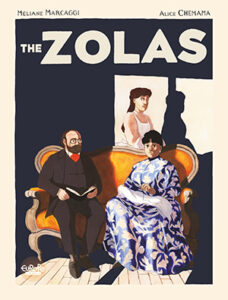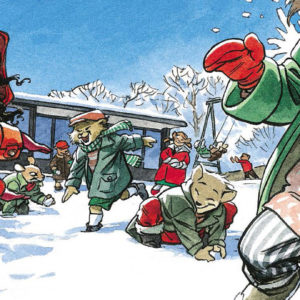We know the brilliant writer of the Rougon-Macquart series and the committed author of the open letter “J’accuse…!” but what do we know about his private life?
Who were the women in his life? How did they help him to accomplish his work? At what sacrifice?
A remarkable fresco that takes us back to the end of the 19th century, to the heart of an ever-changing France and the city of Paris, full of artists and workers.
In 1930s England, the best mystery writers of the era come together to form the Detection Club. G. K. Chesterton, Agatha Christie, John Dickson Carr and others gather to eat, drink, and challenge one another. They are in for a bigger test, however, when eccentric billionaire Roderick Ghyll invites them all to his mansion on a private island off the coast of Cornwall, promising to enchant them with his latest creation: a robot that can predict the culprit in their novels. But when someone ends up murdered, who will lead the investigation? Jean Harambat is back, following the success of “Operation Copperhead,” with a hilarious, satirical take on the classic crime novel.
This is the fascinating life story of Robert Louis Stevenson, the beloved author of classics such as “Treasure Island” and “Strange Case of Dr. Jekyll and Mr. Hyde,” from his early days as an aspiring writer to his first published works, his love affair and then marriage to Fanny Osbourne, his success as an author, his many travels across Europe and the U.S., and finally his voyage to the islands of the South Pacific, where he eventually built the house of his dreams. Stevenson never let his weak lungs (which he referred to as pirates waging a battle inside him) and delicate constitution stand in the way of his insatiable thirst for adventure, living life on his own terms until the very end.
In 1870, Leopold von Sacher-Masoch publishes “Venus in Furs,” an erotic novel revealing the author’s desire to be dominated by a woman. After the success of the novel, a woman turns up at his doorstep and offers to take on the role of the dominant woman. He submits to her completely and they get married. Years later, Leopold has remarried and lives a quiet life, far removed from the sexual escapades of his first marriage. This is when he learns that his surname is being used, to his detriment, to describe a new sexual perversion: masochism.
Entering life at the French royal court, a world in which “what is shown is rarely the truth,” the young Princess of Clèves learns of passion’s torments, of heartbreak, and of the agony of love. Claire Bouilhac and Catel Muller’s graphic-novel adaption of this classic tale—often referred to as the forerunner of the modern psychological novel—remains faithful to the original 17th-century text, while also providing surprising and original insight into both the mystery of the creative act, and the link between the author, Madame de La Fayette, and her heroine, the Princess of Clèves.
In 1864, a year after the death of Eugène Delacroix, Alexandre Dumas recounted the memories that marked his friendship with the great painter. From one anecdote to the next, Dumas’ text reveals the personality of both painter and writer. All the while, a colorful portrait of the period takes shape; a period in which works of art are subject to fiery debates, intense admiration, and irrevocable rejection. With humor and passion, Catherine Meurisse invites herself into this very personal adaptation of Dumas’ tribute to his friend.
Born into an aristocratic family, Percy Bysshe Shelley has no intentions of following in his father’s political footsteps. The rebellious young poet finds himself drawn to more scandalous pursuits: supporting anti-royalist and anti-clerical causes, championing vegetarianism, and extolling the virtues of atheism, an act that ultimately leads to his expulsion from Oxford University.
Book 1 of “Shelley” lets us dive into Percy’s tumultuous childhood, giving us an insight into his friendships with some of the finest progressive thinkers of the times, not to mention his blossoming relationship with his future wife and author of “Frankenstein,” Mary.

The Shelley story continues, the focus now on Mary. Percy has just declared his love for her, but upon being told by her father that he may not take her as his companion, implores her to join him in a suicide pact. Thankfully cooler heads prevail; Mary runs away with Percy—her sister Claire also joining the lovers—and thus begins their European adventure. On their journey, they will meet up with the flamboyant Lord Byron, whose rainy-day suggestion in Switzerland to each write a ghost story will change Mary’s life forever…
Header image: Shelley © David Vandermeulen, David Casanave / Le Lombard
































